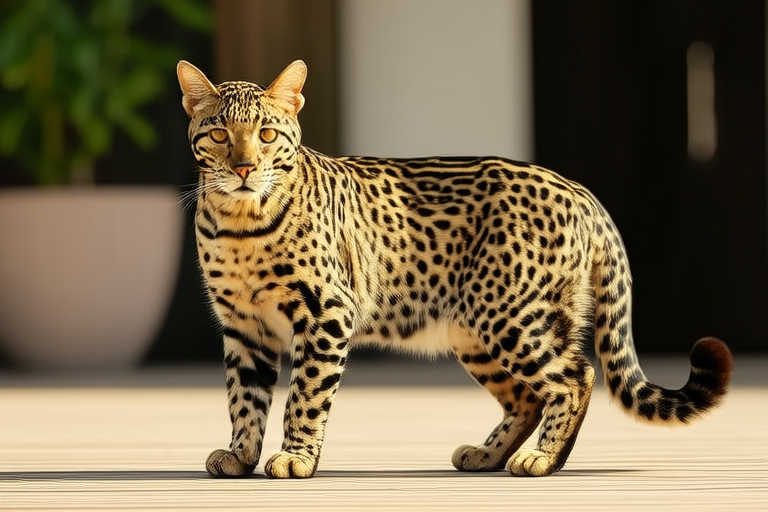Bengal Cats: The Ultimate Guide for Future Owners
Welcome to your comprehensive guide to one of the most fascinating and energetic cat breeds: the Bengal cat. Whether you’re a seasoned cat owner or just considering adopting your first feline friend, this guide will help you understand what makes Bengal cats unique and how best to care for them.
Introduction to Bengal Cats
The Bengal cat is a relatively new breed, having been developed in the 1960s through selective breeding of domestic cats with Asian leopard cats. Their striking appearance, which includes a sleek coat with distinctive spots or marbling, and their playful demeanor have made them increasingly popular among cat enthusiasts. Bengals are known for their vibrant personalities and their ability to engage with humans in ways that many other cats cannot. They are often described as being more dog-like than typical cats, displaying loyalty and affection towards their owners.
Temperament and Energy Levels
Bengals are highly intelligent and curious creatures, which means they require plenty of mental stimulation and physical activity. They tend to be very active during the day, often engaging in play sessions that can last for hours. Their high energy levels mean that they are not suited for those who prefer a quieter, more sedentary pet. However, their intelligence also makes them trainable, and many Bengals enjoy learning tricks or playing fetch. Potential owners should be prepared for a cat that will demand attention and interaction.
Care Requirements
Diet
When it comes to feeding your Bengal cat, a balanced diet rich in protein is essential. High-quality commercial cat food formulated for active breeds like the Bengal is recommended. It’s important to avoid overfeeding, as Bengals can become overweight if given too much food. Fresh water should always be available, and treats should be given sparingly to prevent obesity.
Grooming
Bengals have short, dense coats that are easy to maintain but still require regular grooming. Weekly brushing helps remove loose hair and prevents matting. Bathing may be necessary occasionally, especially if your Bengal enjoys swimming or gets dirty easily. Regular nail trimming and dental hygiene are also important aspects of their care routine.
Exercise Needs
Given their high energy levels, Bengals need ample opportunities for exercise. Providing climbing structures, interactive toys, and spaces for exploration can help keep them entertained and healthy. Consider incorporating playtime into your daily routine, using toys that encourage jumping, chasing, and problem-solving. Mental stimulation is just as crucial as physical activity, so puzzle feeders and games that challenge their minds are beneficial.
Health Considerations
While generally healthy, Bengal cats are prone to certain genetic conditions, including hypertrophic cardiomyopathy (HCM) and progressive retinal atrophy (PRA). Regular veterinary check-ups are crucial for early detection and management of these issues. Vaccinations, flea control, and parasite prevention should also be part of their healthcare regimen.
Creating a Suitable Living Environment
Housing
Bengals thrive in environments where they can explore and express themselves freely. A spacious home with secure access to outdoor areas is ideal, though not all Bengals should have free roam outside due to safety concerns. Indoor enrichment through toys, scratching posts, and vertical space is vital for keeping them happy and healthy. Ensure that windows are securely screened to prevent accidental escapes.
Safety Tips
To keep your Bengal safe, it’s important to secure any potential hazards within the home. This includes securing electrical cords, ensuring small objects are out of reach, and providing escape-proof litter boxes. Supervision when introducing them to new environments or situations is recommended until you understand their behavior fully.
Training and Socialization
Early socialization is key to raising a well-adjusted Bengal cat. Expose them to various people, animals, sounds, and environments from a young age to help them become comfortable and confident. Positive reinforcement techniques work well for training Bengals; rewarding good behavior with treats or praise encourages repetition. Teaching basic commands like ‘sit,’ ‘stay,’ or ‘come’ can strengthen the bond between you and your Bengal while providing mental stimulation.
Common Myths About Bengal Cats
One common myth about Bengal cats is that they are wild animals that cannot be tamed. In reality, Bengal cats are fully domesticated and make wonderful pets when properly socialized. Another misconception is that they require less maintenance than other breeds because of their short coats. While their coats are easier to groom compared to long-haired breeds, they still need regular care to stay healthy and happy. Lastly, some believe that Bengal cats are aggressive by nature. However, with proper handling and socialization, Bengals can be gentle and affectionate companions.
Resources for New Owners
If you’re new to owning a Bengal cat, there are numerous resources available to help you along the way. Local breeder associations offer valuable information about responsible breeding practices and can connect you with experienced breeders. Online forums and social media groups provide support networks where you can share experiences and advice with fellow Bengal owners. Additionally, books and articles written by veterinarians specializing in exotic breeds can provide deeper insights into caring for your unique pet.
In conclusion, owning a Bengal cat is a rewarding experience filled with joy, excitement, and challenges. By understanding their unique needs and providing appropriate care, you can ensure that your Bengal remains healthy, happy, and an integral part of your family. Remember, every Bengal has its own personality and quirks, so take time to get to know yours and adapt accordingly.
